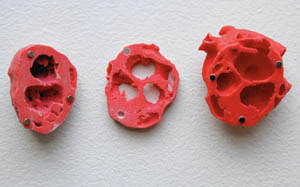


The surgery was a success. Myla, of Coal City, Ill., is now a thriving 4-year-old, attending preschool, acting silly and insisting as many kids her age do, that she can do everything herself. Her mother calls her recovery a miracle.
Plunkett, a doctor at Children's Hospital of Illinois in Peoria, said the surgery helped Myla, who was born with a heart defect, turn a corner. Without the 3-D printed heart, "There was a significant possibility that I would get in there, try to patch over this area, and not necessarily get all of the holes."
Though the practice still isn't widespread, some doctors and hospitals are printing 3-D models of patients' hearts to help prepare for operations. With use of 3-D printed heart models expected to grow, Illinois hospital system OSF HealthCare and the federal National Institutes of Health hope to partner with the American Heart Association to improve the quality of printed hearts, with the goal of helping more patients. OSF has 10 hospitals in Illinois, all outside the Chicago area, including OSF Saint Francis Medical Center in Peoria and OSF Saint Anthony Medical Center in Rockford.
The groups want to create an online database of 3-D printed hearts from patients with congenital heart defects, reviewed by experts in the field. The idea is to help standardize the process of printing hearts.
Congenital heart defects are problems with the structure of the heart at birth. They're the most common type of birth defect, affecting eight out of every 1,000 newborns, according to the National Institutes of Health's National Heart, Lung and Blood Institute. Some defects are easy to fix and others, such as Myla's, require multiple surgeries.
The printed hearts can help doctors in tricky cases such as Myla's, doctors say. They also can help parents like Kramer, who found it reassuring to see the 3-D heart before Myla's surgery, and hear the surgeon explain his plan.
"That understanding, that's a precious thing for a family that's getting ready to go through surgery on their child," said Dr. Matthew Bramlet, a pediatric cardiologist at the Children's Hospital of Illinois.
At OSF HealthCare's Jump Trading Simulation & Education Center in Peoria, which printed Myla's heart, engineers typically take an MRI or CT scan of a patient's heart and run the scan through computer programs that allow them to print plaster composite hearts in three dimensions, Bramlet said.
Source: http://www.chicagotribune.com/business/ct-3d-printed-hearts-surgery-1023-biz-20161021-story.html